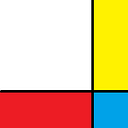Bosch: A Surreal Spectrum of the Garden
耶罗尼米斯·博斯(Hieronymus Bosch)是早期弗拉芒画派的画家,正如我们在介绍安托内罗的文章中所提到的那样,弗拉芒画派的特点是画家们在画作中会使用虚构遐想的手法,增加幽默、讽刺的元素。大师博斯将弗拉芒画派的这一特点发挥至极致,因而他也被称为“超现实主义的启蒙者”。
Hieronymus Bosch was a painter of the early Flemish school. As we introduced Antonello last week, the Flemish school typifies painting with fictional imagination, humor, and satire. Bosch brought this characteristic of the Flemish School to the best practice, and therefore he was called the “surrealist enlightener”.
博斯的画作充满着博斯特有的悲观气质,包含天马行空的想象和怪诞不经的设计,但历史上却没有太多关于博斯的生平记载,因而对于他画作的解读多种多样,难以达成统一。此外,他没有在画作上留名的习惯,可他的独树一帜的绘画风格却为他带来了大量模仿者。据说收藏家John G. Johnson收藏的九张博斯画作中,只有一张是出自博斯之手。种种因素,让博斯和他的画作成为了神秘的代名词。
Bosch’s paintings are full of his pessimistic temperament, from imaginary elements to the grotesque and bizarre design. There are few records about Bosch and his personal life, and so the interpretation of his paintings can be vastly diverse and essentially difficult to achieve a scholarly consensus. In addition, he never named his paintings, but his unique style of painting brought him a lot of imitators. It is said that among the nine Bosch paintings collected by collector John G. Johnson, only one is from Bosch. Various factors have made Bos and his paintings mysterious.
《人间乐园》是博斯最著名的一幅三联画。画面的左联和右联合起来后,便可以看到下图所示的外部。
“The Garden of Earthly Delights” is Bosch ’s most well-known triptych. If we combine the left and right of the screen, we can see the exterior shown in the figure below.
学者们通常认为外部面板描绘了“世界的创造”。面板颜色单一,依稀可以辨认出山脉的形状,褪去的潮水,和新生的树木。左上角是年迈的上帝,他的膝盖上放着圣经,旁边用拉丁文写着:因为他的话,才变得如此;他命令了,才有了一切。可以推测出这是《圣经》中创世第三天的情景。
Scholars usually think that the outer panel depicts the “creation of the world.” The color of the panel is single, and the shape of the mountains, the faded tide, and the new trees can be easily recognized. In the upper left corner is the elderly God, with the Bible on his knees and Latin writing next to it: because of what he said, it became so; he ordered everything. It can be speculated that this is the third day of creation in the Bible.
内部面板左侧描绘的是“伊甸园”。画中较为年轻的上帝正在将夏娃介绍给亚当。夏娃身后的兔子象征着“多产”,对面的一棵龙树代表着永恒。在背景中,我们还可以找到长颈鹿,大象,狮子,鱼,鸟,猫,蜥蜴等等生物,这些生物在博斯的年代并不常见,因而有学者认为这是博斯从一些旅行日记(如Cyriac of Ancona’s travelogues)中学习到的。
The “Eden” is depicted on the left side of the interior panel. The younger God in the painting is introducing Eve to Adam. The rabbit behind Eve symbolizes “prolific”, and a dragon tree opposite stands for eternity. In the background, we can also find giraffes, elephants, lions, fish, birds, cats, lizards and other creatures. These creatures are not common in the age of Bosch, so some scholars think that this is Bosch ’s travel diary learned in Cyriac of Ancona’s travelogues).
内部面板中部描绘的是“人间乐园”。从地平线看,左联和中部的地平线相连,因而可以推测出,中联中的人是亚当和夏娃的后代。再考虑到中联和右联时间上得连续性,“人间乐园”描绘的是大洪水之后的场景。根据圣经,大洪水因人的堕落而起,但洪水后,人类却依旧重蹈覆辙。将上帝忘得一干二净,甚至忘了上帝对他们“繁衍”的期望(图中没有孩子)。但值得注意的是,博斯并没有使用谴责的笔触来描绘这一场面。通常来说,博斯会用衰老和腐烂来谴责罪恶,但这里的人类显得天真无知,他们纵欲、享乐却不觉得自己在做错事,这里的水果熟透诱人、色泽鲜艳。那么之后会发生什么呢?博斯似乎是在暗示“水果的感官诱惑及其腐败之后就色香全无的自然属性与人类的轻浮有共通之处”。
The middle part of the inner panel depicts a “The Garden of Earthly Delights”. From the horizon, the left couplet is connected to the central horizon, so it can be inferred that the people in the couplet are descendants of Adam and Eve. Taking into account the time continuity of the League of Nations and the Right League, the “The Garden of Earthly Delights” depicts the scene after the Great Flood. According to the Bible, the Great Flood started because of the descend of man, but after the flood, humanity still repeats the same mistakes. Forgetting God completely, even forgetting God’s expectation for them to “give birth” (there are no children in the picture). But it is worth noting that Bosch did not use condemnation to describe this scene. Generally speaking, Bosch condemns sin with aging and decay, but the humans here are naive and ignorant. They do not feel that they are doing something wrong with indulgence and pleasure. The fruits here are ripe and attractive, with bright colors. So what happens afterward? Bosch seems to be suggesting that “the fruit’s sensory temptation and its corruption have nothing in common with the frivolity of human nature.”
内部面板右侧描绘的是“地狱”。画面中充满了大火、折磨、不安。据说博斯居住的小镇曾经发生过大火,因而大火成为了“博斯式地狱”的典型象征。在这里,我们看到老鼠、兔子、鸟、狗等动物穿上了人的衣服,似乎在代替上帝惩罚着堕落的人类。
The right side of the inner panel depicts “Hell”. The picture is full of fire, torture, and anxiety. It is said that there was a fire in the town where Boss lived, so the fire became a typical symbol of “Bosch’s hell”. Here, we see animals such as mice, rabbits, birds, and dogs wearing human clothes, which seem to be punishing fallen human beings instead of God.
在博斯的作品中,我们很难发现一个主人公。他习惯描绘一个宏大的场面,构建一个完整的宇宙,而后再把这位“无形主人公”所经历的苦难,面对的诱惑,做出的选择一一呈现出来。只要有心,我们甚至可以从他的作品中找出时代的蛛丝马迹(包括美食、音乐、天气、科技、交通等等),读懂他的情感(通过种种隐喻和象征物)。这位画家将所有的细节融合在一起,而后创作出了这个拥有前因后果,交融了现实和想象,怪诞却精美的世界。
In Bosch’s work, it is difficult to find a protagonist. He is used to depicting a grand scene, constructing a complete universe, and then presenting the sufferings, temptations, and choices made by this “invisible protagonist” one by one. As long as we have the heart, we can even find traces of the times (including food, music, weather, technology, transportation, etc.) from his works, and read his emotions (through various metaphors and symbols). The painter merged all the details together, and then created this grotesque but exquisite world with antecedents and consequences, blending reality and imagination.
Reference: http://wap.art.ifeng.com/?app=system&controller=artmobile&action=content&contentid=3470758
